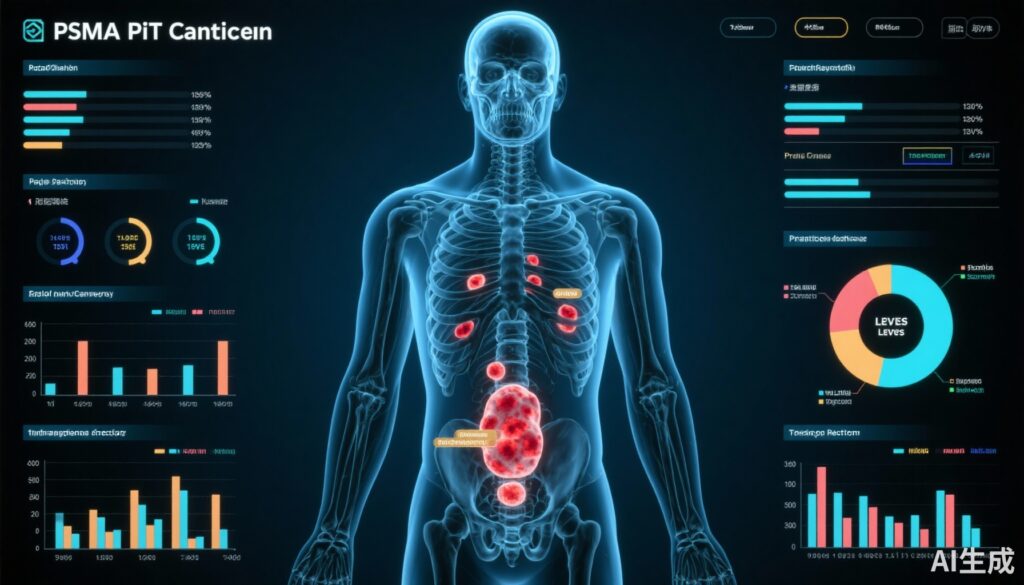Highlight
1. A novel visual whole-body tumor-burden classification scheme based on PSMA PET/CT (MDT scheme) robustly predicts response to androgen receptor signaling inhibitors (ARSIs) in metastatic hormone-sensitive prostate cancer (mHSPC).
2. MDT high tumor burden correlates with significantly poorer prostate-specific antigen (PSA) response and survival outcomes, especially in patients treated with second-generation ARSIs.
3. PSA reduction ≥ 99% (PSA99) is a valuable endpoint for prognostic evaluation in mHSPC.
4. This classification provides superior predictive and prognostic accuracy compared to existing tumor-burden schemes, facilitating personalized treatment strategies.
Study Background
Metastatic hormone-sensitive prostate cancer (mHSPC) represents an advanced and clinically challenging stage characterized by hormone sensitivity but metastatic dissemination. Incidence rates of mHSPC have been rising, underscoring the urgent need for optimized treatment stratification. Current standard-of-care involves androgen deprivation therapy (ADT) combined with androgen receptor signaling inhibitors (ARSIs), which have demonstrated survival benefits in randomized controlled trials. However, patient response to these therapies is heterogeneous, with some individuals exhibiting insufficient PSA response or rapid progression. Accurately predicting treatment response and prognosis remains an unmet clinical need to guide individualized therapy and improve outcomes.
Prostate-specific membrane antigen (PSMA) positron emission tomography/computed tomography (PET/CT) is emerging as a highly sensitive imaging modality to evaluate prostate cancer distribution and tumor burden. Although PSMA PET/CT-based tumor-burden classification schemes have been validated in the context of PSMA-targeted radioligand therapy, their utility in predicting responses to hormone therapies such as ARSIs is less well understood. This study hypothesized that a novel, visually guided whole-body tumor-burden classification system based on PSMA PET/CT could enable selective patient stratification and prognostic assessment in mHSPC patients receiving hormone therapies.
Study Design
This retrospective cohort study included 165 patients diagnosed with de novo mHSPC confirmed pathologically and by [18F]F-PSMA PET/CT imaging from February 2022 to December 2023 at a single institution. Inclusion criteria mandated treatment with at least six months of hormone therapy: ADT alone, ADT plus first-generation antiandrogens, or ADT plus second-generation/novel ARSIs. A multidisciplinary team (MDT) developed a visual whole-body tumor-burden classification scheme leveraging PSMA PET/CT images, stratifying patients into high versus low tumor-burden groups based on three criteria: (I) >10 metastatic lesions with PSMA uptake higher than parotid gland in ≥80% of lesions, counting diffuse single bone involvement as four lesions; (II) presence of visceral metastasis; or (III) at least four bone metastases with at least one outside vertebral bodies or pelvis.
For comparative analysis, the study also assessed three established PSMA PET/CT tumor-burden classifications: PSMA-CHAARTED, PSMA-LATITUDE, and revised-vPSG schemes. Quantitative PET parameters such as SUVmax, SUVpeak, SUVmean, tumor volume (TV) metrics of primary and metastatic sites, and ratios to physiological background uptake were calculated. Primary outcomes were PSA response defined as PSA <0.2 ng/ml after six months, and PSA99 (≥99% PSA reduction) for survival analysis. Logistic regression models evaluated predictors of PSA response, and Cox proportional hazards regression analyzed prognostic factors for survival endpoints. Statistical significance was set at P < 0.05.
Key Findings
The cohort’s mean age was 69.3 years. In univariate logistic regression across all 165 patients, MDT classification, PSMA-CHAARTED, revised-vPSG schemes, hormone treatment type, and primary tumor volume correlated significantly with PSA response, while PSMA-LATITUDE was not predictive. Multivariate analysis identified three independent predictors: MDT high tumor burden (OR 5.34, 95% CI 2.40–11.87, P < 0.001), treatment with second-generation ARSIs (OR 0.21 compared to ADT or first-generation antiandrogens, P = 0.001), and primary tumor volume ≥12.49 cm3 (OR 2.93, P = 0.014).
Subgroup analysis of 133 patients receiving ADT plus second-generation ARSIs demonstrated that MDT classification and primary tumor volume remained independent predictors of PSA response (OR 5.73 and 2.75 respectively). The combined predictive model including these factors achieved an area under the curve (AUC) of 0.751 for this subgroup, indicating strong discriminative ability.
Survival analyses showed patients on second-generation ARSIs attained PSA remission more rapidly (P < 0.001). In multivariate Cox models, MDT low tumor burden (HR 0.52, P < 0.001) and second-generation ARSI treatment (HR 3.34, P < 0.001) independently predicted improved survival. Within the ADT plus second-generation ARSI group, MDT classification was the sole independent prognostic indicator for PSA99 outcome (HR 0.47, P < 0.001), outperforming alternative tumor-burden schemes.
These findings underscore the superiority of the MDT visual whole-body tumor-burden classification in stratifying mHSPC patients for likelihood of favorable response to novel ARSIs and survival prognosis. PSA99 emerged as a superior endpoint to evaluate meaningful treatment efficacy.
Expert Commentary
This study addresses a critical gap in precision oncology for mHSPC by integrating advanced molecular imaging with clinical prognostication. PSMA PET/CT provides high-resolution whole-body metastatic mapping, enabling nuanced assessment beyond total lesion counts, incorporating lesion PSMA intensity and distribution patterns. The MDT scheme pragmatically combines lesion quantity, uptake intensity, and metastatic site criteria to capture clinically relevant tumor burden heterogeneity.
Integration of tumor volume metrics with imaging-derived tumor burden and treatment type enhances predictive accuracy. The robust association of MDT high tumor burden with poor PSA response and prognosis, particularly in patients receiving second-generation ARSIs, aligns with biological plausibility that extensive and metabolically active disease exhibits intrinsic resistance mechanisms.
Compared to prior tumor-burden models, this visual classification demonstrates superior discriminatory power, likely due to multidimensional criteria capturing tumor biology and dissemination patterns. Limitations include its retrospective single-center design and limited follow-up duration. Prospective multicentric validation and correlation with long-term survival and quality-of-life outcomes are warranted. Additionally, mechanistic studies exploring biological correlates of PSMA PET uptake and therapeutic resistance may further refine stratification.
Conclusion
The novel visual whole-body tumor-burden classification based on PSMA PET/CT imaging represents a promising tool to predict and prognosticate treatment response in mHSPC patients receiving ADT combined with ARSIs, especially second-generation agents. It aids in stratifying patients into distinct risk groups that correlate with PSA response and survival outcomes, potentially guiding personalized treatment decisions and clinical trial designs. PSA99 is validated as a meaningful endpoint for response evaluation in this population. Future research should focus on prospective validation, integration with molecular biomarkers, and evaluation of clinical utility to optimize management pathways for mHSPC.
Funding and Clinical Trials
The study was conducted at a single institution with no specific external funding reported. Prospective clinical trials are needed to confirm these findings.
References
Liao X, Li S, Sun H, et al. A visual whole-body tumor-burden classification based on PSMA PET/CT to predict response to novel androgen receptor signaling inhibitors for metastatic hormone-sensitive prostate cancer patients. Eur J Nucl Med Mol Imaging. 2025 Oct;52(12):4399-4413. doi:10.1007/s00259-025-07300-4. Epub 2025 Apr 25. PMID: 40278858.



